By Bruce Dorn
Photography by Bruce Dorn and Scott Brady
The Hunt
A pack of African wild dogs trotted directly towards us. Absolutely alert, they moved with that easy, ground-eating pace that typifies a pack of totally focused predators on the hunt. Our safari driver swiftly braked in hopes of creating a steadier camera platform for us. The dogs flowed around the vehicle as easily as a mountain stream around a boulder: the first dog split to our left, the second to our right, and the third to our left. So it went until all 22 had passed us in utter silence. Once the canine hunting party was safely clear, our driver whipped us through a quick, three-point turn around and we began to shadow the dogs from a discrete distance.
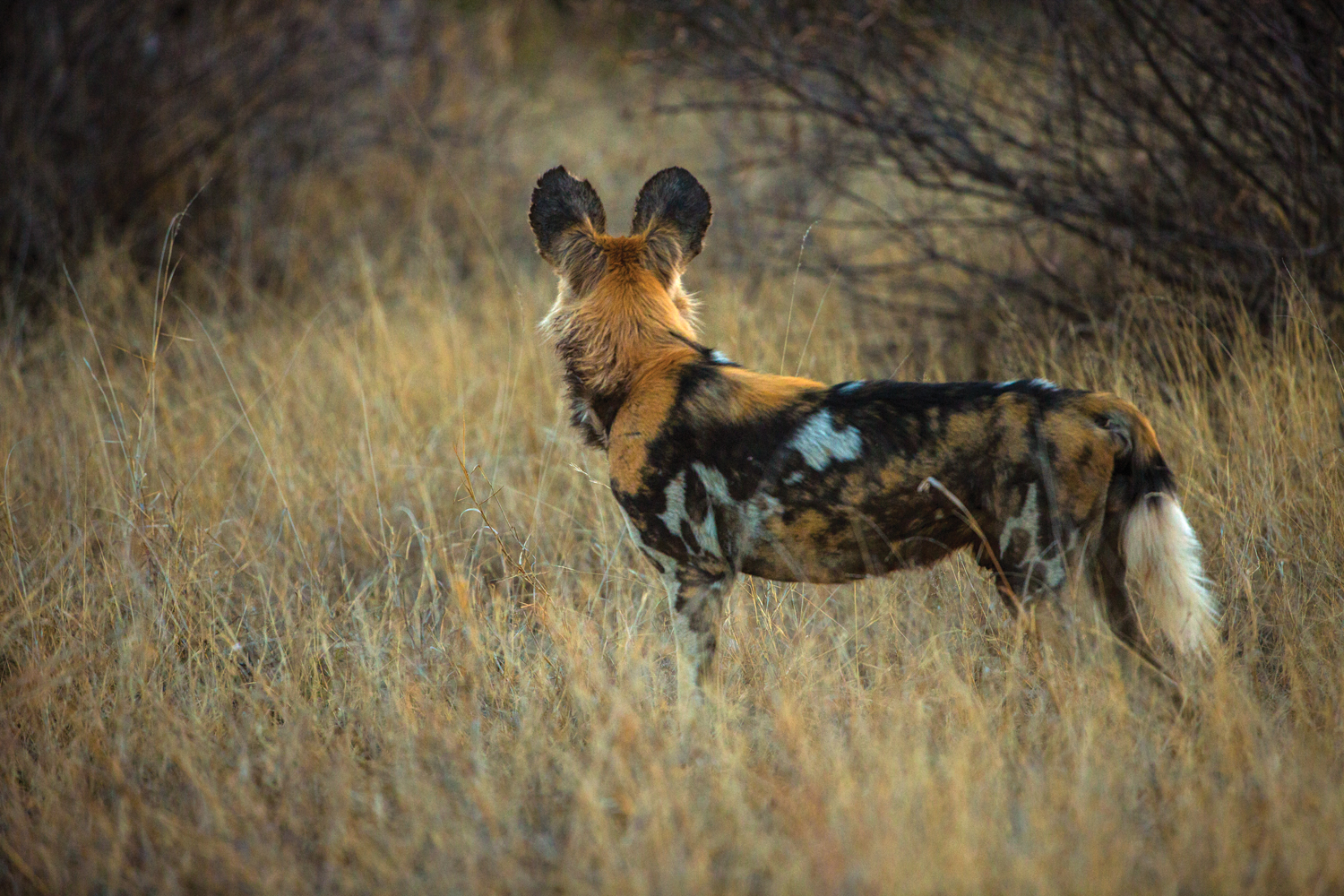
Unlike the solitary great cats, which depend upon stealth and short sprints to catch prey, canines are coursers. Coursing hunters use endurance and coordinated teamwork to harass and run their quarry to the point of exhaustion. In the case of wild dogs, which are not averse to fast food, they often begin their meal well before the entrée ceases to run. Though highly efficient, the grisly practice of disemboweling their prey before it falls has earned them a “cruel” reputation—which has led to them being harassed, hunted, and poisoned nearly to the point of extinction. We followed the pack until sunset when they quietly evaporated into thick, impenetrable brush. While stopped for sundowners before the long drive back to Thakadu River Camp, radio reports indicated that the pack had materialized again some 7 kilometers from our location, still on the hunt.
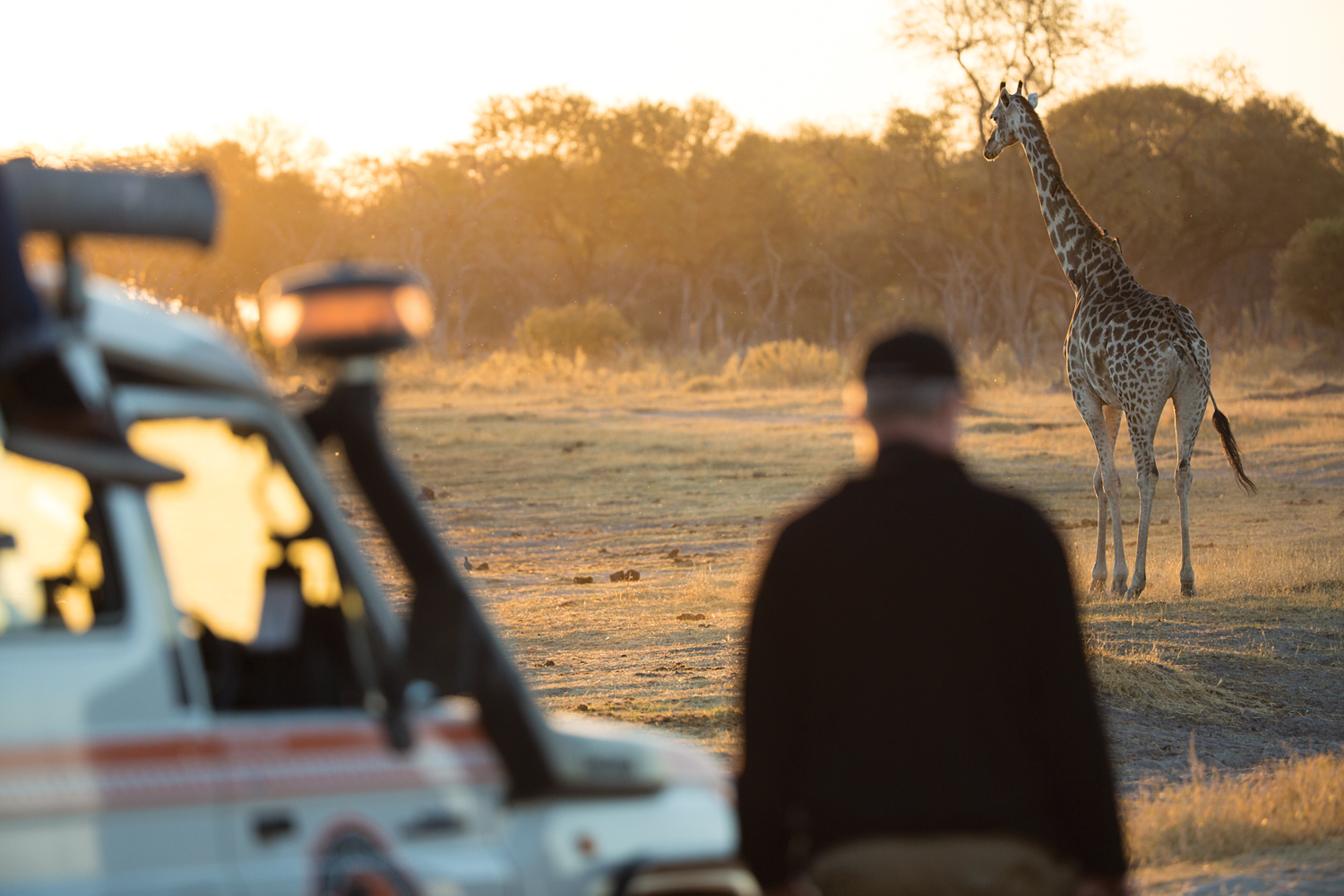
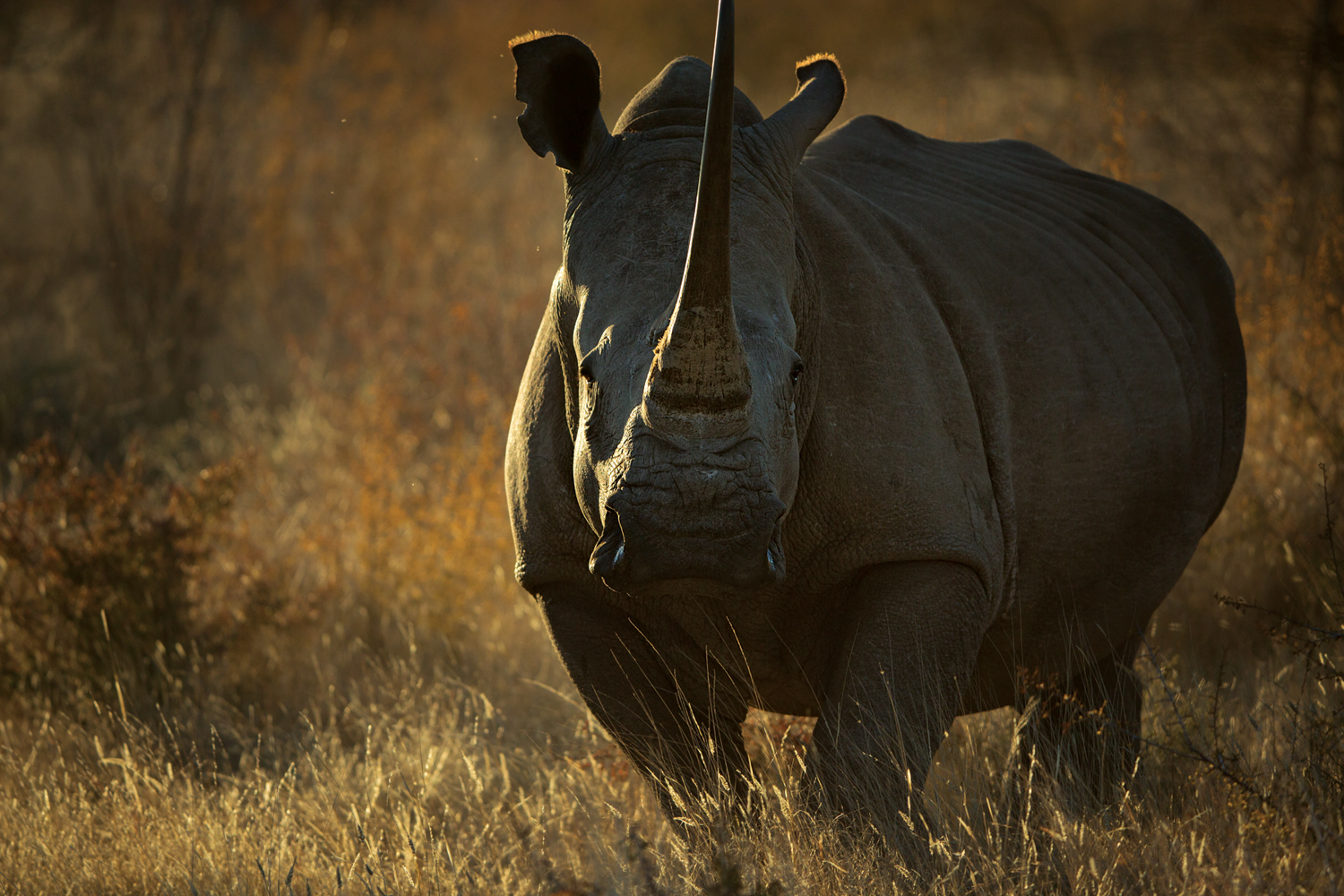
If you ranked a continent’s capacity to entertain based upon the number of indigenous critters that can kill you (in my book that’s a perfectly legitimate way to do so), Australia ranks right up there. They’ve got irritable saltwater crocs, elusive-but-vicious drop bears, and of course, pretty much anything that wriggles, flies, or hops is poisonous. North America has polar bears, grizzlies, wolves, and cougars, but few are likely to come sniffing around your tent on any given night. Europe has a smattering of wolves and bears tucked away who-knows-where, and I hope that there are still a few un-poached tigers burning brightly in some dark patch of Siberian or Indian forest. South America has pumas and Central America offers jaguars and jumbo snakes (though I wouldn’t count on one in camp). Antarctica has her pecker-faced penguins…and I suppose someone could, while taking a selfie, tumble off of an ice shelf and plummet directly into the waiting jaws of a leopard seal.
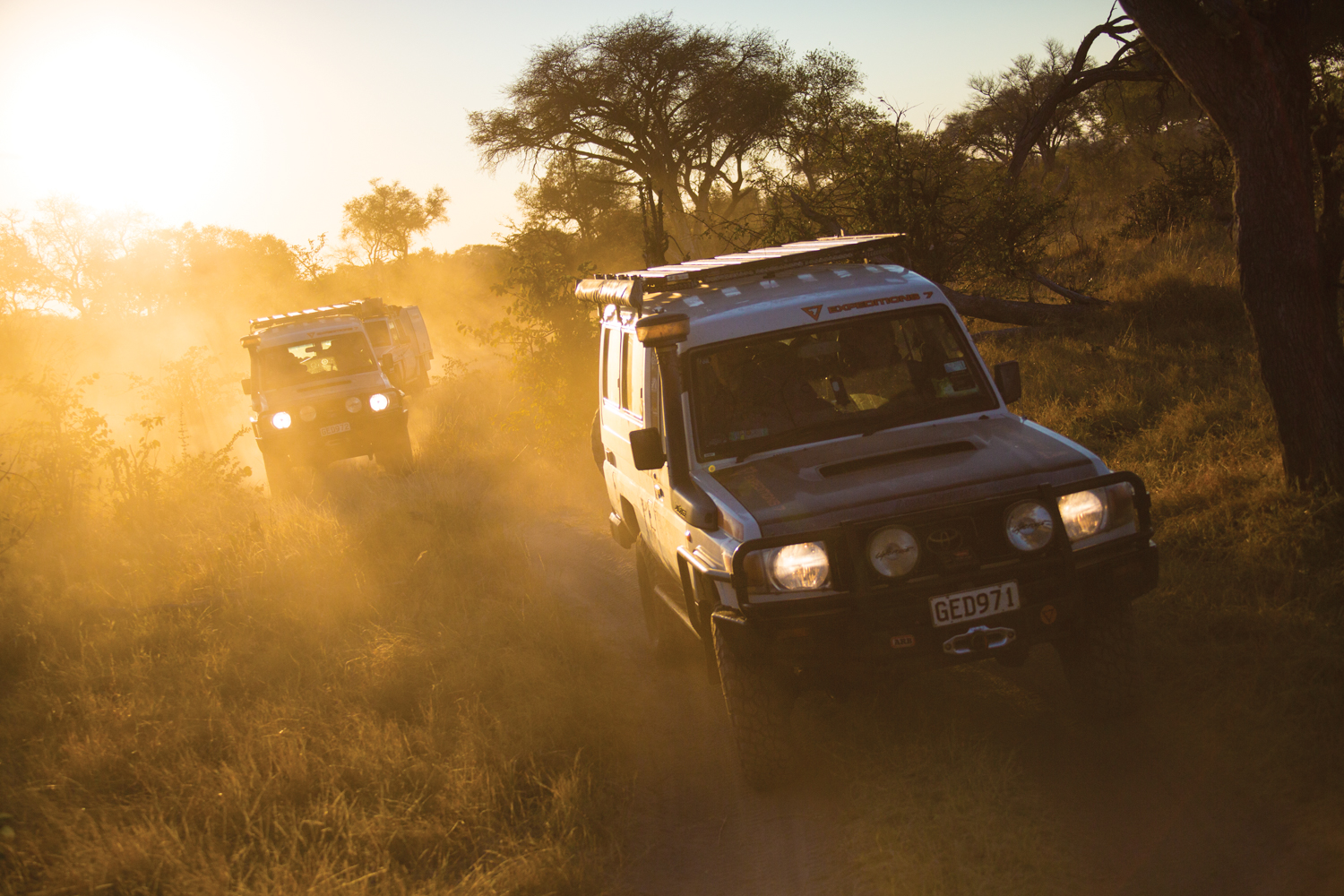
That leaves Africa as our final contender for the top ranking. While I’m unsure about the relative lethality of an angered aardvark, I certainly wouldn’t care to be stomped into smithereens by a zebra. Add in the alphabet soup of incredibly tough animals that fall in-between, and I contend that Africa is the clear and undisputed winner—even without adjusting the criterion to include the stuff that will happily both kill and eat you.
In Search of the Rhino
A few weeks earlier we’d rolled north from our staging point in Johannesburg, South Africa, and began the African segment of Expeditions 7 (E7) by camping on a wild bit of rural property owned by Front Runner’s founder, Stanley Illman. Located in an area famous for private hunting concessions, this campsite offered team members their first glimpses of a nice assortment of free-range prey species. Enjoying a gleaming African campfire, we dined on lollipop-like veal chops that were grilled to perfection on one of Front Runner’s elegantly designed wheel-mount Braais. After tidying up camp to avoid the possibility of a nocturnal visit by hyenas, we crawled into our sleeping bags to escape the surprisingly chilly evening air.
Previous legs of E7 featured ambitious distances and tight timetables, which conspired to make our first four continents seem more like uber-long rally stages than classic expeditions. I was glad the team leaders decided to bite off a smaller chunk of this leg: one that focused a bit more on quality rather than quantity, one that we could chew on more slowly, thoughtfully, and thoroughly. Given that there are, as Robert Ruark famously said, “miles and miles of bloody Africa” to explore, I felt the decision would result in a deeper and more satisfying experience for all.
The following day we rallied hard, E7 style, towards Serowe, Botswana, and reached the Khama Rhino Sanctuary by early afternoon. Established in 1992, the sanctuary covers almost 8,600 hectares and provides a vast and safe habitat for a handful of ultra-rare black rhinos, white rhinos, and more than 30 other African species. After off-loading our camp gear under a sprawling tree, we took advantage of the last hours of daylight to initiate a self-drive safari around the preserve.
After much fruitless searching, we were beginning to despair of finding even a single rhino when we luckily stumbled into a group of four. We eventually saw 10 in all, including a couple of frisky little calves. They were surprisingly tolerant of our team, if not each other, and shoulder-to-shoulder grazed and tussled their way into the setting sun. Greg commented that, like any loving family, they liked to keep each other close, even if they occasionally got on each other’s nerves a bit.
The rhino horn trade, though illegal, is financially very lucrative and rhinos remain in extreme jeopardy everywhere they exist. Although this particular group is protected by anti-poaching patrols from the Botswana Defense Force, poachers are relentless— meaning that nowhere in Africa is truly safe for an unescorted rhino. Visiting Khama was a beautiful experience and one that I highly recommend to anyone interested in this ancient and amazing beast. Even if you can’t personally experience them in the wild, you can help to preserve them through organizations like the International Rhino Foundation.
The Emerald Jewel of Africa
After a warm night of camping under the trees, we hit the road for Maun, Botswana, where we gathered provisions and rendezvoused with two young African game trackers, Shane and Cat. After collecting them we crossed through a foot-and-mouth disease control checkpoint and pounded our way up dusty silt track to a campsite in the Khwai Development Trust area, hard on the banks of the slowly filling Okavango Delta.
The Okavango Delta is the expansive terminus of the Okavango River, a river that empties not into a sea, but rather a vast and shallow freshwater swamp. It reminds me a bit of the Florida Everglades, minus the mosquitos. When seasonal rains from the mountains of Angola and Rwanda find their way down to the Okavango River and eventually flood across the delta, it becomes a veritable magnet for all manner of wildlife. During the wet season the delta is as close to a contemporary Eden as you’re ever likely to find—cool July temperatures, warm sun, gin-clear water, and zero, I repeat, zero, biting insects. Our timing was perfect.
Having hosted multiple luxury photo safaris in Botswana over the years, this game-rich area is like a second home to me. If you’ve ever watched a National Geographic special on Africa, one that wasn’t shot on the East African plains of the Maasai Mara or the Serengeti, it was almost certainly filmed in the Okavango. It’s also very likely it was filmed at a famous photography concession like Jao, Chitabe, Savuti or Kings Pool. While all are luxurious and posh camps, none offer better game viewing than we encountered on the evening of our arrival. After setting up camp within earshot of a group of contentedly rumbling elephants, we drove to the nearest watercourse where we were rewarded with what resembled nothing less than a passenger queue for Noah’s Ark.
Elephants cavorted in chest-deep water, while massive crocs sunned on nearby banks. Hippos in deep riverine pools postured and displayed their deadly ivory, while giraffes oversaw our arrival from a higher vantage point. No cats were to be seen, but hey, that’s how they roll. We parked amongst the gathered throng, quieted our chuckling turbo-diesels, and proceeded to soak up what I considered to be my own private Africa. Impending darkness drove us back to camp for a quick dinner before an evening game drive to hunt (with our cameras) for leopards and lions. It was a chilly drive and not particularly productive, but that’s why we call it “hunting” and not “finding.”
After an animated campfire conversation, Greg lingered by the fire to edit his day’s photos while everyone else retreated to bed. I was settling in when I noticed the camp cleanup crew, two spotted hyenas, quietly sneaking up behind Greg’s fireside position. I doubt they intended to snatch him away, but nevertheless I mentioned them to him in sotto voce. Glancing over his shoulder, he rather quickly decided that his photo editing could wait until another time.
The annual flooding of the Okavango Delta is a large and sprawling event, and as capable as our Toyotas are at terrestrial and limited aquatic exploration, it’s hard to beat an aerial overview. After a brief morning game drive we met with a Maun-based helicopter service for a series of scenic flights, flights that left everyone wide-eyed and raving about the amazing sights they’d seen. In order to take advantage of the more photographically dramatic lighting of the “magic hour,” my apprentice shooter Josh Miller and I elected to take the last flight of the day.
With the ground team back on the trail and motoring towards an agreed upon cinematic rendezvous, Josh and I prepped our camera gear and loaded it into the helicopter. Everything was going swimmingly until the pre-flight spool-up of our little Robinson R44 triggered a magneto failure alarm. The engine has back-up systems, of course, but flying on your spares is a terrible idea; we were effectively grounded. With no other transportation available, and the rest of the team outside the range of our 2-meter radios, we had no alternative but to sit tight and wait until our concerned teammates came looking for us. Though the perfect conditions of late-afternoon light were lost, after a bit of lastminute finagling we were able to organize another chopper and pilot for the following day. The ultimate result of our aerial antics would be some cool water-crossing footage and, fortunately, no one falling out of the sky.
The following day we crossed into Namibia and motored smoothly towards the small but sophisticated metropolis of Windhoek. I’d be remiss if I didn’t comment on the utter perfection of the graded dirt tracks that make up much of Namibia’s roadway system. Our Troopies are lovely vehicles indeed, but during this stretch I would have gladly traded them all for a Subaru WRX or Mitsubishi EVO shod with gravel tires. These impeccably groomed roads are awesome! Perhaps their perfection is a residual effect of Namibia’s historic colonial governance and their German occupier’s legendary sense of “order in all things.” Whatever the case, I’m going back with a rally car at the earliest opportunity.
Arriving in Windhoek, we briefly relaxed before provisioning and meeting up with our colorful Namibian Guide, Volker Jahnke. We had experienced one of Southern Africa’s finest water features and would now explore one the region’s most dramatic geological regions: the red dunes of Sossusvlei in the spectacularly beautiful Namib-Naukluft National Park.
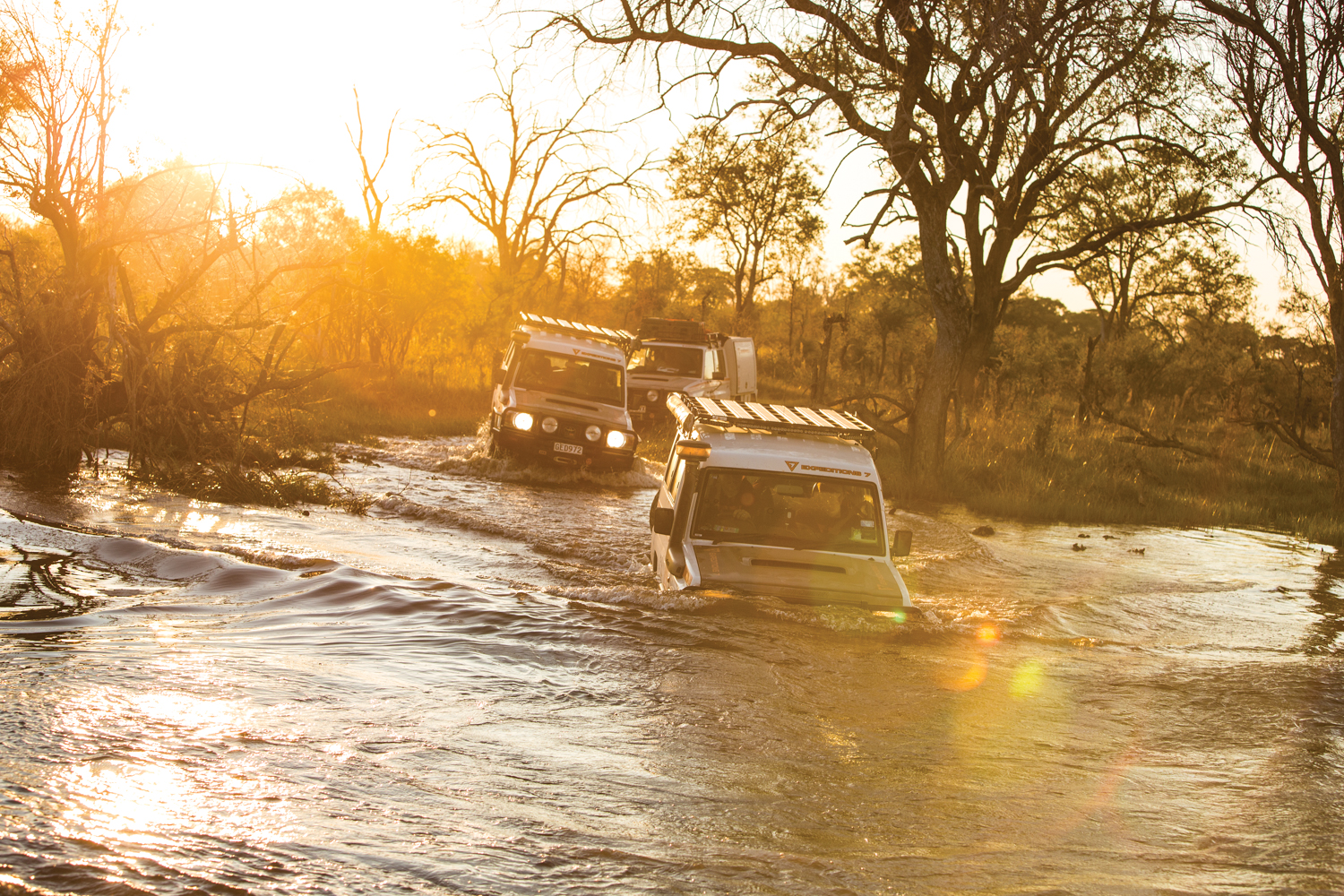
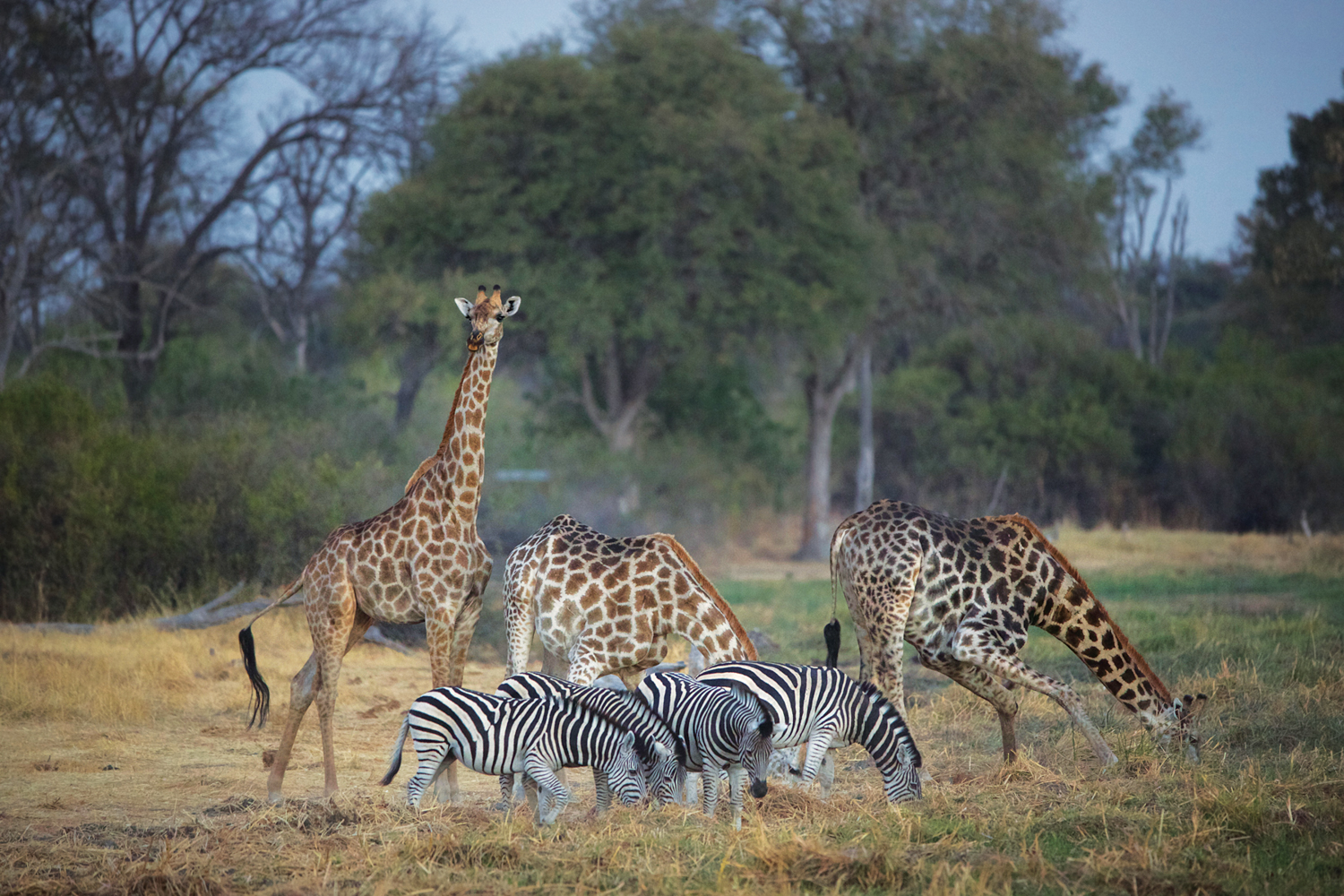
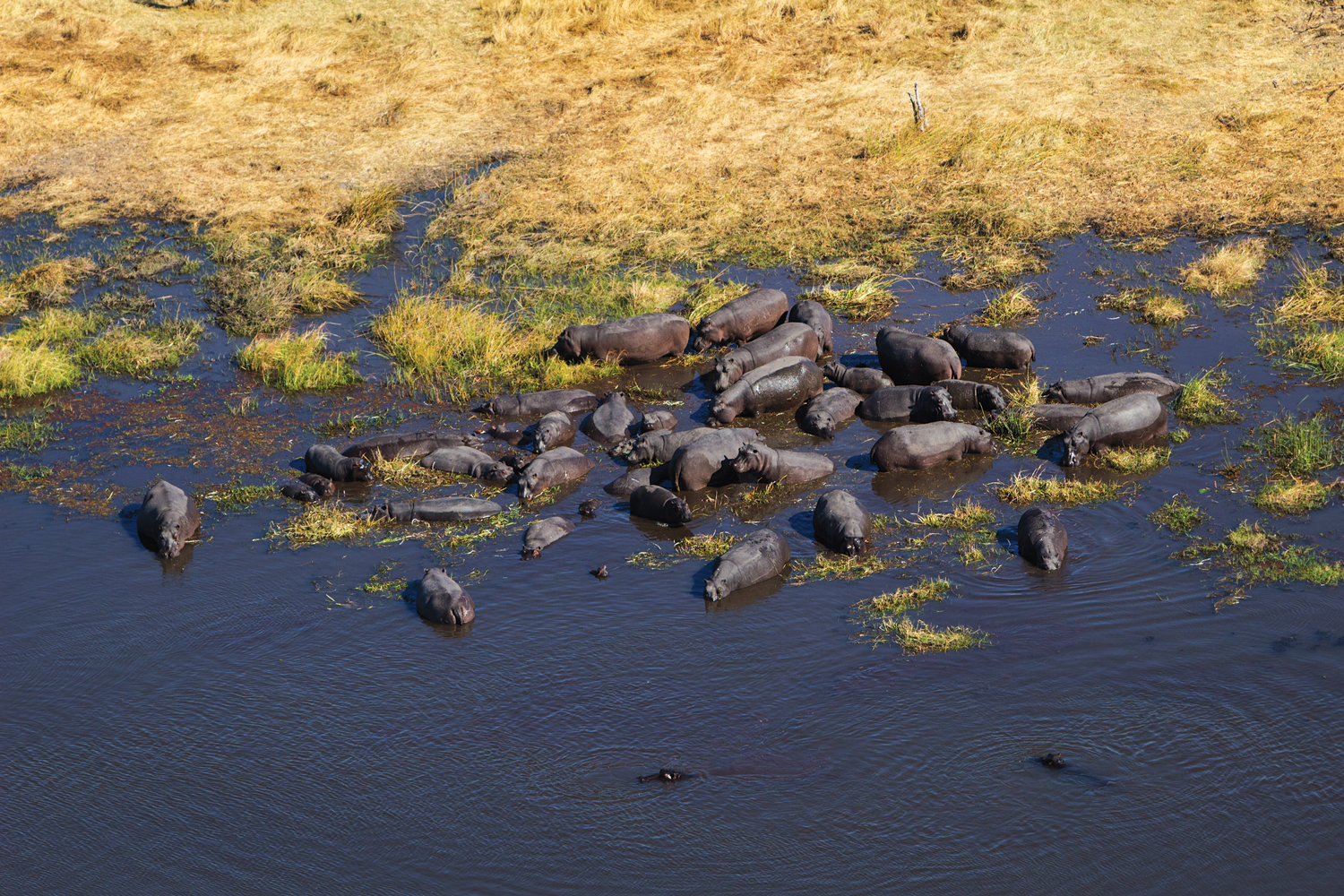
Namibia’s Great Sand Sea
In Sossusvlei we exercised a rarely issued permit and continued well past the traditional tourist boundaries. After bidding our park service chaperone goodbye and receiving a detailed dune-driving tutorial from Volker, we attacked our first real dune. Sure, we had driven over endless dunes in Australia, but those were mere ripples compared to these sand massifs.
In an effort to capture quality footage of the E7 caravan, I rode shotgun with Volker for the first section. Volker drives a frisky little petrol-powered Toyota pickup and seemed to subscribe to the philosophy that if the rpm weren’t bouncing off of the rev limiter, we just weren’t having fun. As we raced ahead (so I could set up for some impressive “Master Shots”), I made a game of trying to predict Volker’s line through the dunes. I was never right. Understanding that man has to know his limitations, I immediately and silently relegated myself to the rank of “follower” when it comes to dune navigation.
This area featured sparsely scattered vegetation, yet we soon spotted the first of many oryx. Sporting long, sabre-like horns, these large desert antelope, also known by some as the gemsbok, are able to survive without water for extended periods of time. Standing stock-still, glaring at us with facial expressions that could only be described as dumbfounded, they seemed absolutely astonished to see our strange caravan. Wonderfully adapted to the arid conditions of the Namib dunes, oryx have been reported to gather fog-generated moisture by licking the dew off of the backs of their fellow herd mates. Incorrigible team mechanic Kurt Williams immediately tried this technique with me but I wasn’t having any of it.
Moving beyond the shallower, vegetated foothills we soon achieved high ground and beheld an amazing view: immense red dunes stretching on for as far as the eye could see. At last, I thought…this is what I signed on for.
And so began what I consider to be the essence of overland adventure: to travel through a truly wild place, one marked with no route whatsoever. This traverse took the form of an endless organic rollercoaster, one that, if ridden in an ever-westward direction, would eventually spill us out onto the equally desolate Skeleton Coast.
Yee-Haaaaw! Our design-it-yourself thrill ride lasted for two solid days and covered several hundred kilometers. With a combination of reduced tire pressures and savvy route selection, I was frankly amazed with the climbing ability of the Toyotas. We quickly learned (the hard way) about maintaining momentum and not high-centering atop sharp dune crests. But most of our “stucks” were minor and easily rectified with the judicious application of a long-handled shovel. I don’t recall ever employing our ever-ready MAXTRAX sand mats, but was very glad we had them along. While we did roll one lightly inflated tire off of the rim, it was quick work to lube the bead and pop it back into place. The gutsy little Sherpa II was over-burdened with extra fuel, as usual, but even she managed to churn her way over each and every crest—though sometimes by way of a totally different route. She’s an independent gal but never lagged far behind.
Steep descents were also a revelation. Once the lip of a dune was crested, the trucks would simply squat down into the sand and gently surf their own bow wave to the bottom. What was most interesting to me was the auditory component. The bow wave created a basso profundo kind of sound that was downright eerie in both tone and volume. Not driving, I was free to lean out of the window to observe the phenomenon of sand particles dancing wildly, as if they had been cast into the cone of a giant sub-woofer. It was an amazing thing to see and repeated itself on each and every descent.
Camping consisted of finding a low point that was mostly out of the wind, a spot surrounded by dunes that were not too steep to climb up again without the benefit of momentum. This was clearly not Volker’s first rodeo, as he carried several sections of canvas fencing that could be linked together to form a very effective windbreak. Our meals were still a bit crunchy, but everyone can use a little more roughage in their diet, right?
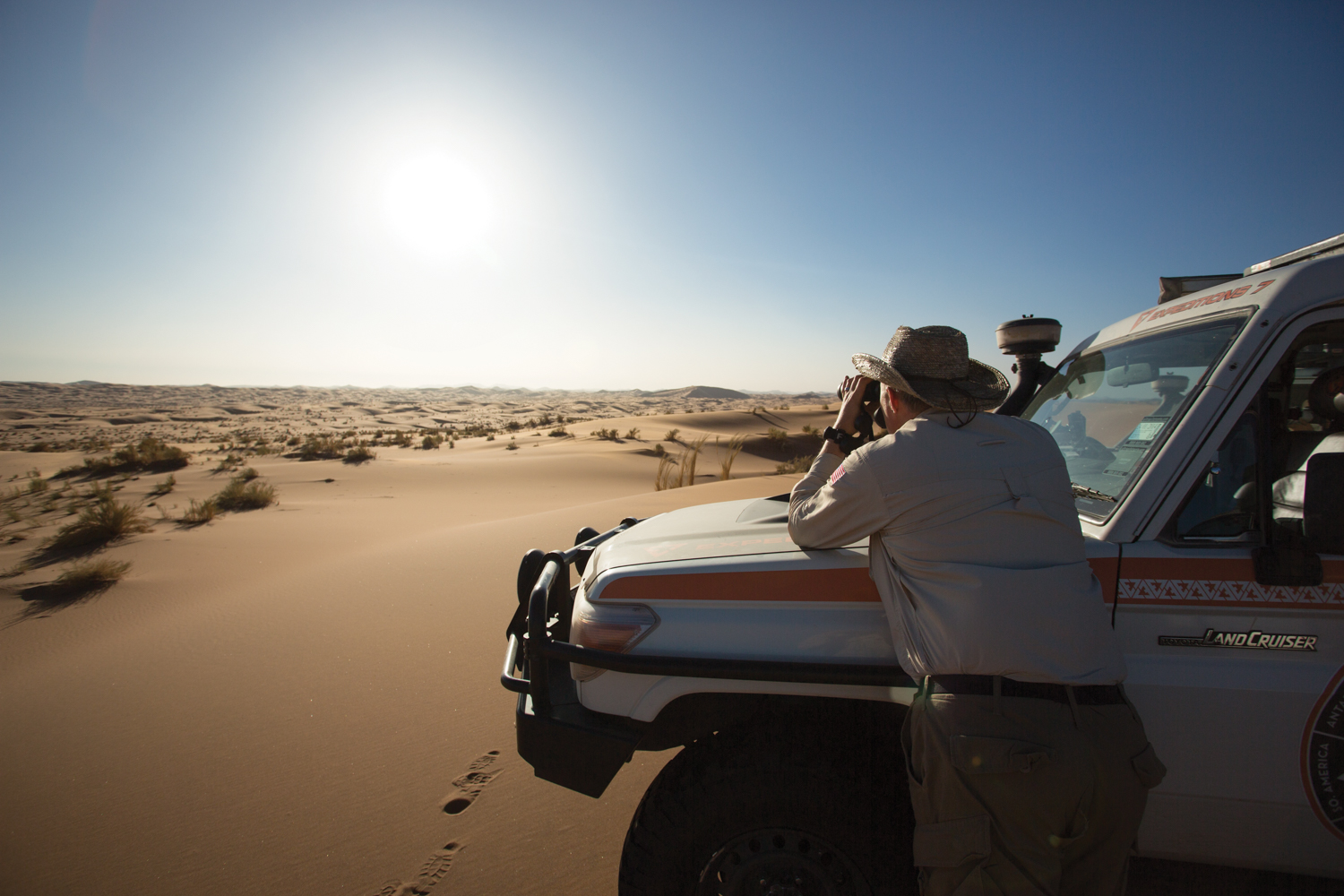
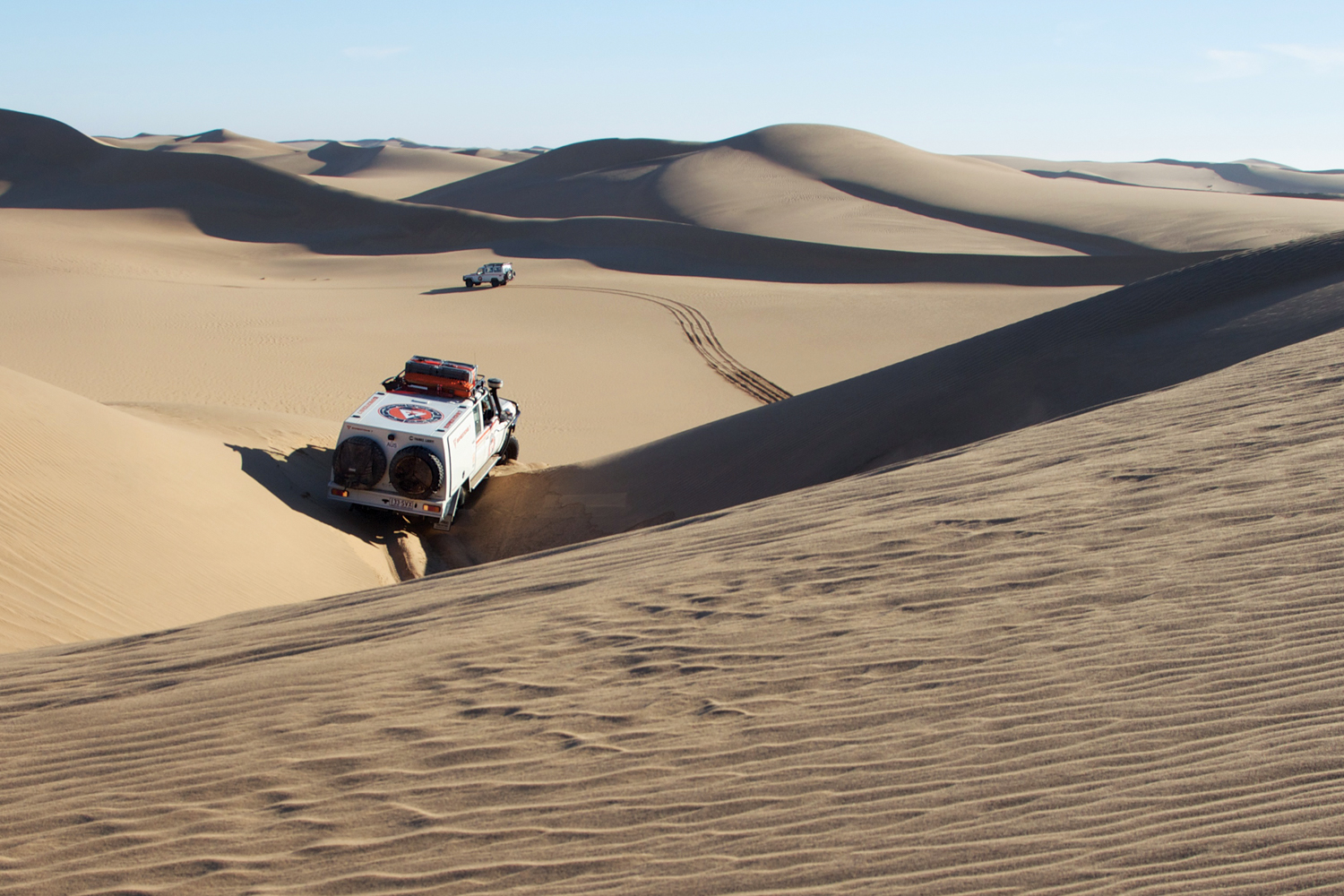
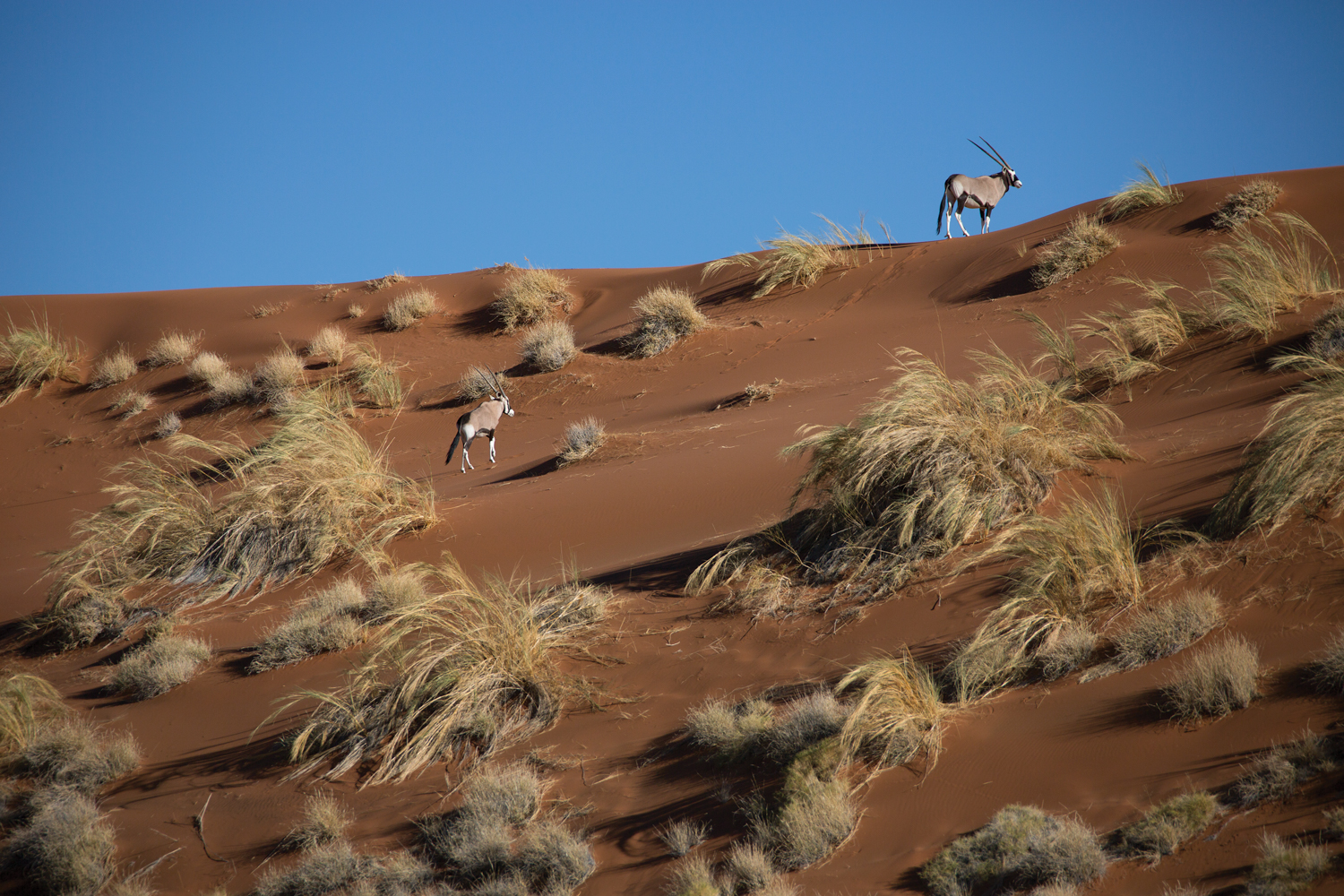
The Skeleton Coast
I don’t know if it was great timing or dumb luck that brought us to the lip of the final dune just before sunset, but we were treated to an unbelievably spectacular ocean view. Peeking over the edge revealed a precipitous slipface that terminated into crashing surf. Our planned route north was on the beach, and we would need every inch of hard-packed sand and every available minute to make the run north to an area where we could escape the inevitable rising tides. After a quick confab, it was decided that we would set up camp and hit the beach in the morning when the water was as far out as possible. If we had vehicle problems or got stuck, and were caught between the dunes and the powerful shore break, we might find it hard not to add a couple of digits to the Skeleton Coast’s impressive body count. Everything had to go just right.
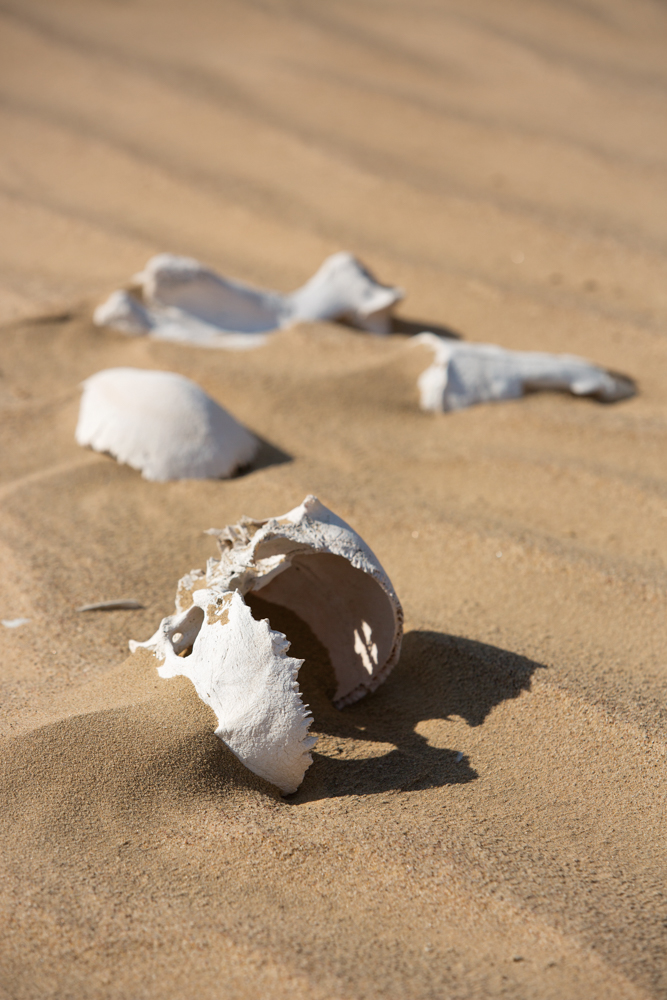

With that settled, the Miller boys, Josh, Oakley, and Bryce, decided that a quick dip in the Atlantic was in order. Launching over the edge, hurtling down the steep slope, and even a spectacular high-speed tumble by Bryce was all fun-and-games, but it was their “death climb” back to high ground that was most entertaining for those who stayed behind. The phrase, “One step forward, two steps back,” never rang truer. I’m sure they all slept very well that night.
Those who sacked out early missed a spectacular experience. We had set our dune-top camp well back from the brink, and a late-night hike to the precipice offered a rare moment of absolute isolation and beauty. An indigo sky sprayed with colorful stars, silvery moonlight illuminating an inky sea, and swirls of phosphorescent algae animating the breakers. It was adventure story perfect.
Low tide corresponded with our plan for a morning departure. After a quick scan of a huge sea lion rookery to the south, we dropped down to the beach, turned north, and put the loud pedals down.
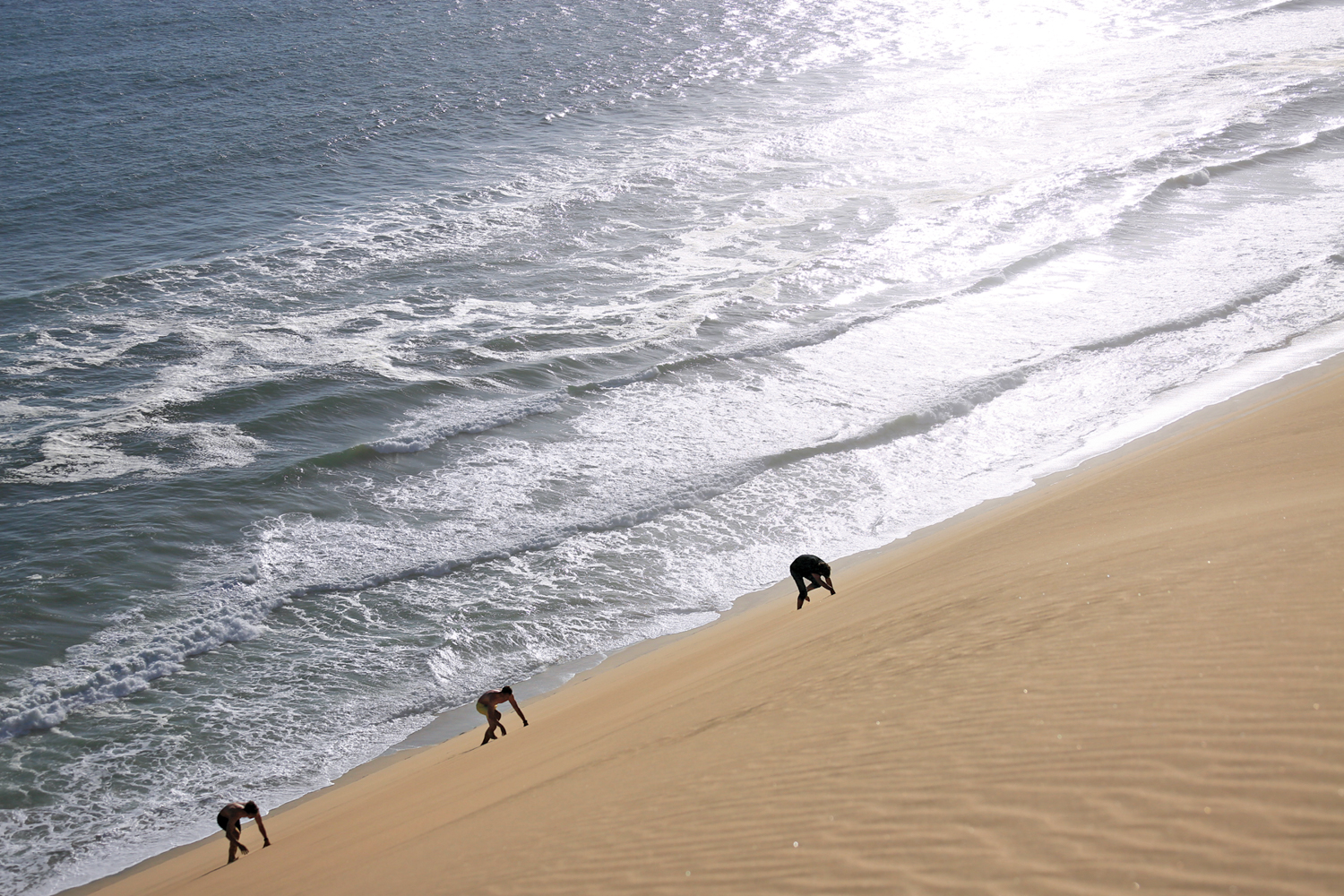
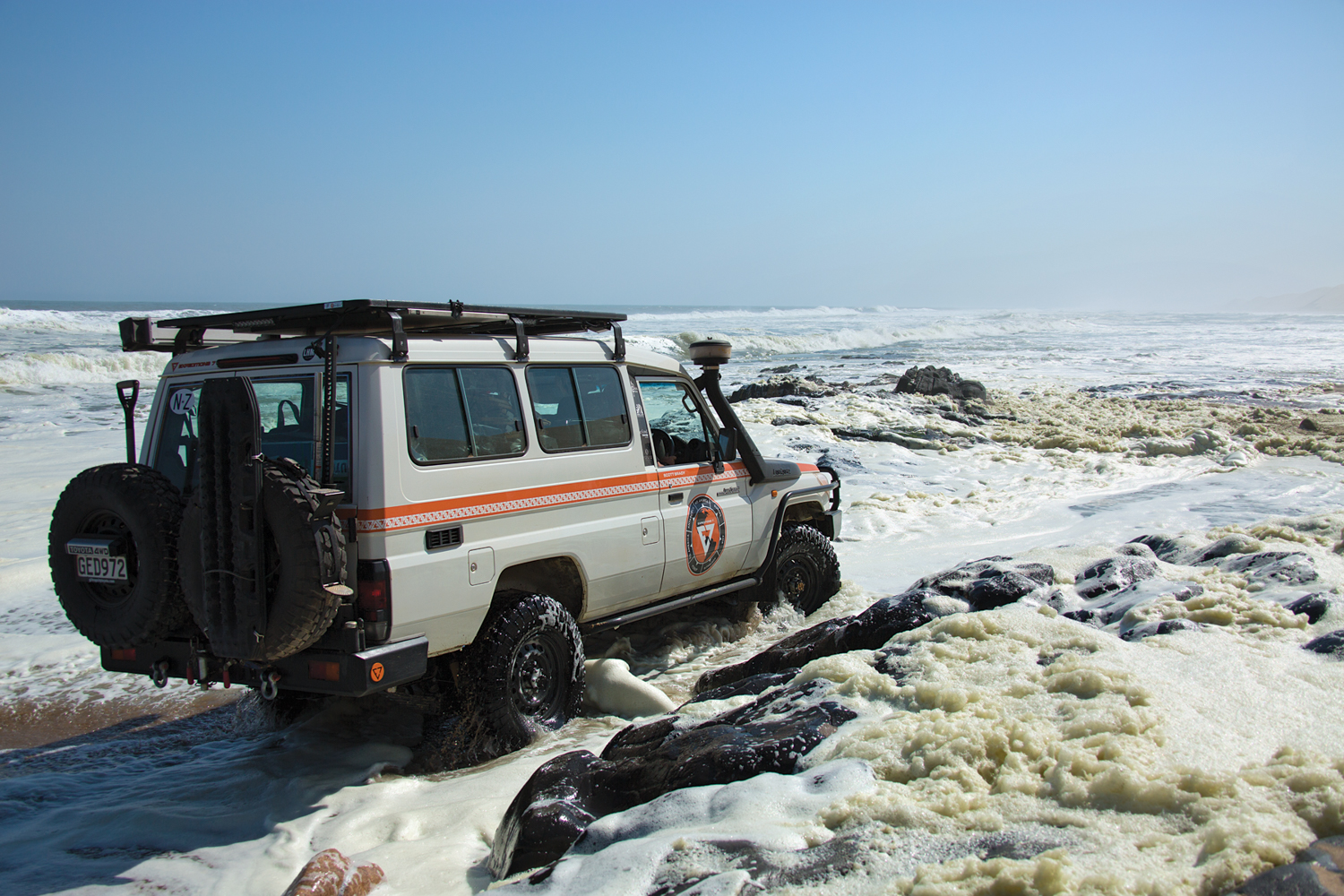
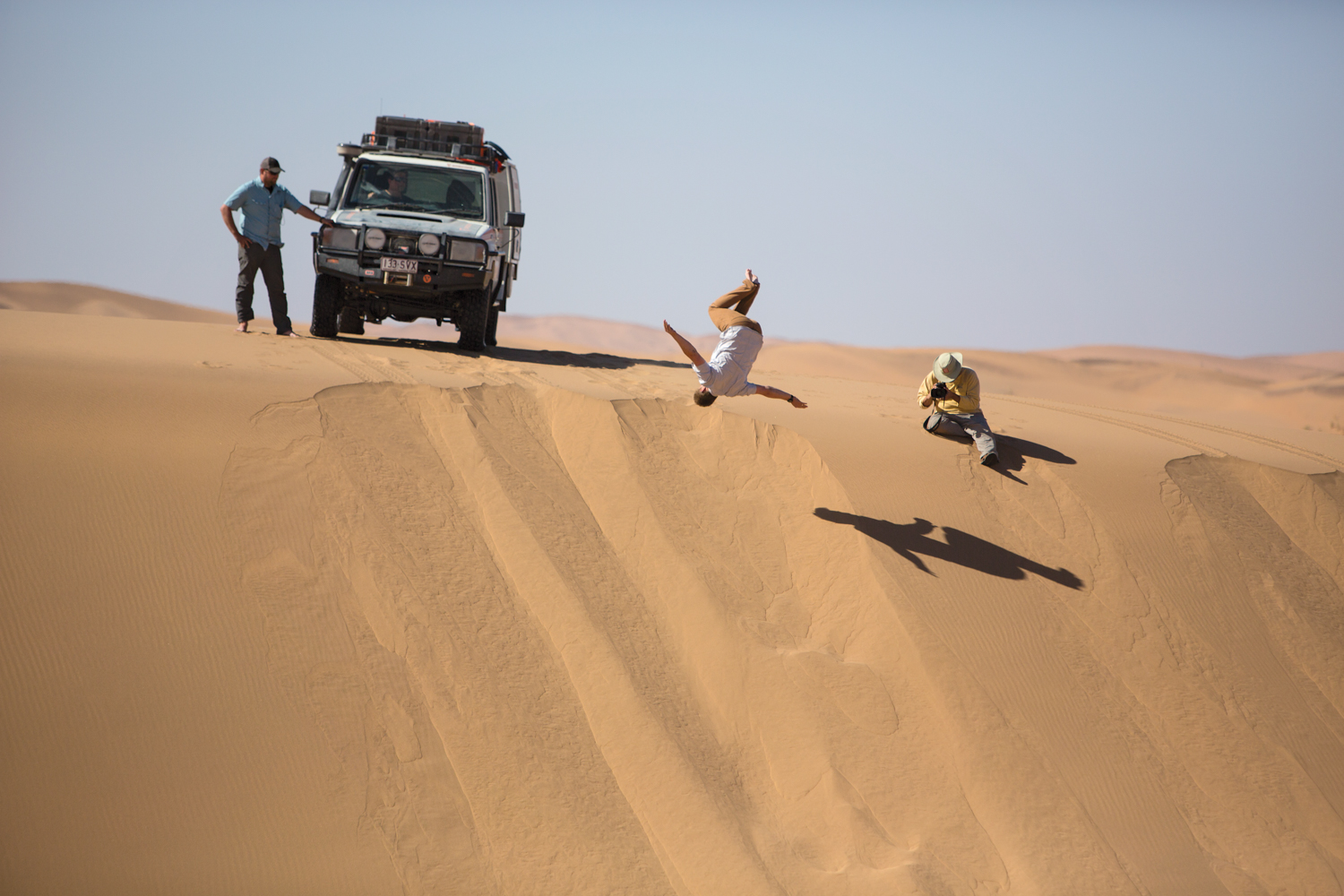
In some stretches, we had 50 yards of navigable beach between the dunes and the surf. In other areas, we needed to tiptoe around rocky outcroppings as huge pillows of surf foam exploded beneath our wheels. Even a cursory glance towards the impossibly steep slipface to our right reminded us of the critical importance of maintaining a steady northward pace. After about 60 kilometers of hard running we found ourselves adjacent to a series of lower, more navigable dunes and were able to slow our speed considerably.
As we entered Meob Bay, the site of a long-abandoned German whaling village, we passed massive piles of whalebones, the bare ribs of forgotten whaling boats, tumbledown wooden shacks, and a half-buried human skull. We weren’t there for very long, but it took little imagination to visualize the backbreaking and bloody work that transpired on this remote shore. I got the impression that one afternoon the whalers realized that they had essentially “gotten them all,” and simply dropped their tools where they stood, leaving without a moment of ceremony.
The German whaling fleet might have been long gone, but small-scale commercial fishing does continue along this wild stretch of the Atlantic coast. Further on we came upon the canvas camp of a small group of Namibian fishermen. When we unexpectedly and noisily appeared, they seemed almost as shocked as the dumbstruck oryx. They proved to be friendly chaps, and we chatted for a few minutes before continuing north.
Later, while wiggling my toes in a wide swath of ruby-red beach sand during one of our photo stops, I asked Volker about its unique colorization and texture. “It’s garnet,” he responded matter-of-factly, “with some ruby and diamond dust mixed in. Wherever you find this sand you’ll find diamonds.”
We were transitioning into another unique geological region: Namibia’s diamond mining district. A pair of 20th-century ghost towns, in which early German colonialists had clearly operated with Teutonic efficiency, Grillenberger and Charlottenfelder were surrounded by a vast inland quartz-sand desert. While poking around the ruins we discovered one relatively intact shack that contained a variety of carefully gathered artifacts. Among the sandblasted and somewhat bland detritus of a typical corporate town we also found a substantial library of pre-war Nazi propaganda. Surreal, really, and I confess that I kept expecting to see Indiana Jones’ much-loved fedora go blowing by on the howling winds.
Though the cold, nutrient-rich water of the southern Atlantic’s Benguela Current attracts both whale and whaler, it also delivers thick fog on a nearly continual basis. But on this day we were blessed with crystal clear skies. With little time until sunset, we decided to forgo setting camp and hurried out to the beach with the intention of capturing some magic hour images of the Eduard Bohlen, a German passenger steamship that had been thrown aground in heavy fog on September 5, 1909. One of literally thousands of ships that have fallen victim to the Skeleton Coast’s infamous fog banks and prevailing onshore winds over the past 500 years, the rusting bones of the Eduard Bohlen now lies some 400 meters inland. Once the lair of a hyena that preyed upon the hundreds of sea lions that inhabit nearby beaches, this shipwreck is about as spooky as anything I’ve seen. Its 95-meter-long steel hulk is indeed an eerie sight to behold, and is the perfect symbol of Namibia’s dangerous and remote Skeleton Coast.
With teeth chattering (from the cold, not fear) we quickly explored the rusting hulk as darkness fell. If we had hung back and camped at the ghost towns, as others had suggested, and approached the shipwreck the following morning, we would have missed what turned out to be absolutely perfect afternoon light. In photography, as in so many things, timing is everything. Never wait ’til tomorrow for a shot you can get today, says I.
The next day revealed yet another shipwreck, the trawler Shawnee, (which is rumored to have been run aground as part of an insurance fraud), and huge flocks of flamingos that lined the lower reaches of Walvis Bay. As we traversed the last of the dunes, just below the busy port city of Swakopmund, we encountered scenic flight flyovers and a couple of Land Rovers, busily bringing tourists for brief jaunts into the dunes. I wonder what they made of us, what their pilots and drivers might have had to say on the matter? I’ll bet it would have been priceless.
As I tried to adjust to our sudden re-entry into the modern world, I felt more than a little bit of sadness. Not one of us had been eaten, bitten, stung, charged, or even—if you don’t count the oryx—glared at…dang it! All was not lost though; there were still miles and miles of bloody Africa to explore. We said our goodbyes to several team members who needed to head back to the States, and turned our wheels towards the Thakadu River Camp in the Madikwe Game Reserve, South Africa.
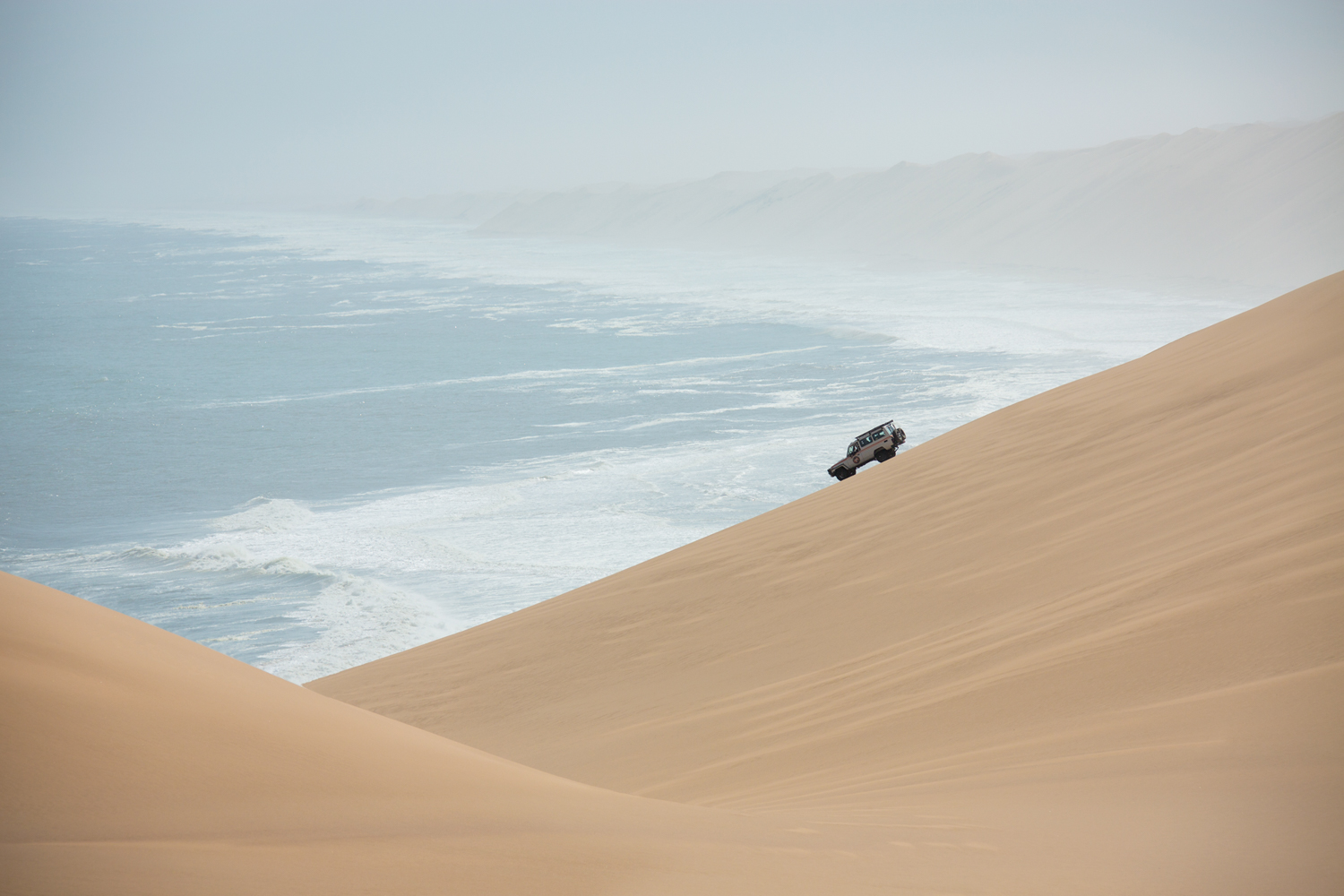


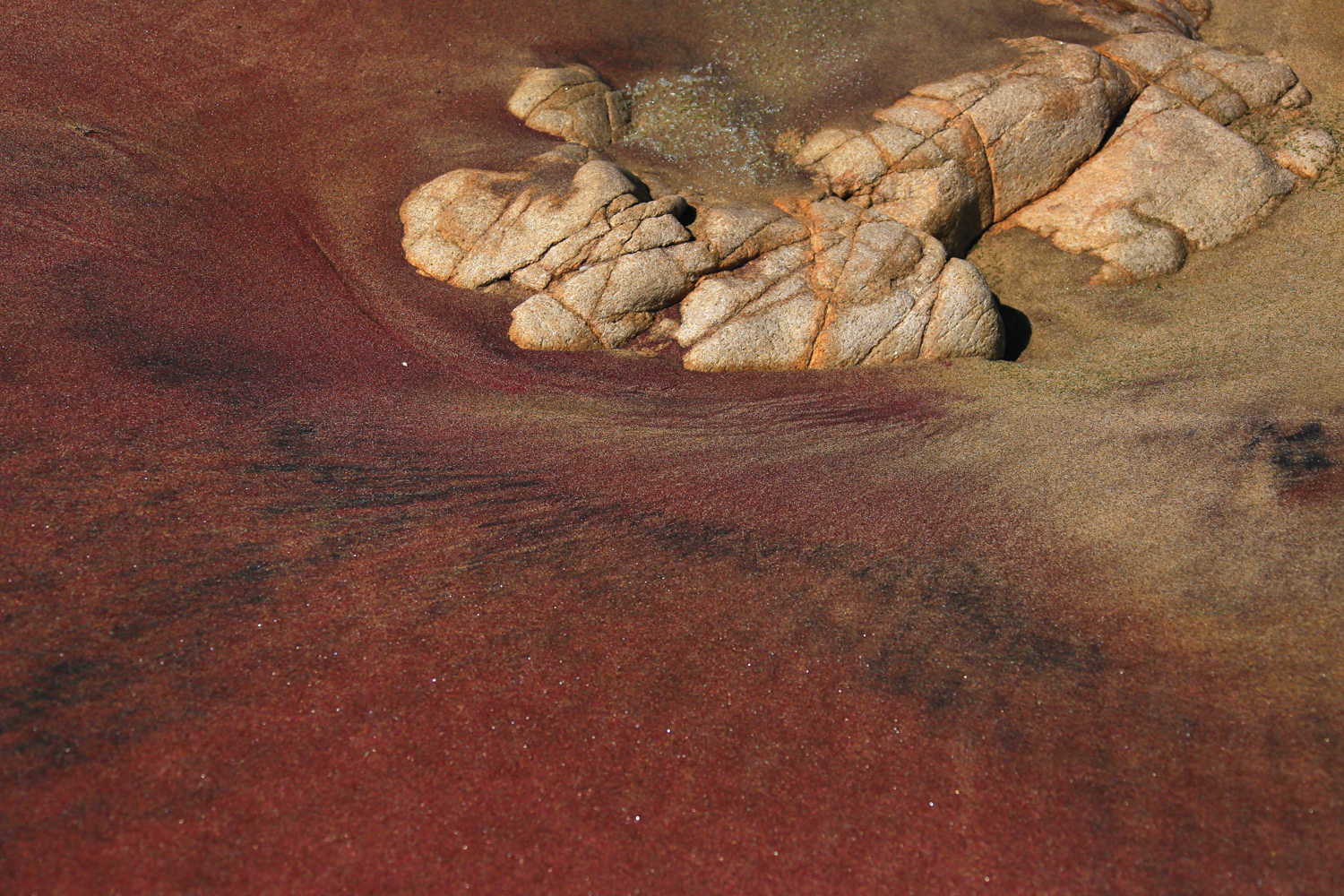
Things That Go Bump In The Night
It was Africa dark and bone-numbingly cold as we slowly motored our way back towards the Thakadu River Camp. I’d decided it was far too dark to capture any kind of non-flash photos, so I put away my fancy-schmancy cameras and snuggled down into my woolen comforter.
I had snagged the seat directly behind the driver, as I always try to do when not tasked with tracking. Hopeful to add something interesting to our day’s game count, our wheelman drove with one hand, searching trailside trees with an anemic red-filtered, hand-held spotlight. Though optimistic, we saw a whole lot of nuthin’.
Just as we were beginning to drift off in reflective thought, there was a rush of movement in the darkness to our right. The mighty “whang” of a fast-moving body colliding with sheet metal instantly followed. We were hit and hit hard, as if by a speeding motorcycle, enough to rock our truck on its heavy duty springs. As I struggled to rationalize this crazy thought, our driver whipped the spotlight down to illuminate the area just below his door. The sequence of events that followed played out in a rapid-fire series of disjointed frames painted red with the guide’s spotlight…and blood.
The first fleeting image revealed a deeply dented door panel and a large female impala, stone-cold dead from an instantly broken neck. The second image, triggered by another rush of movement in the underbrush, was that of a swarm of snarling and snapping wild dogs. They were back. The pack had chased the ewe, at full-speed, directly into the side of our safari truck. They were on her in an instant.
Concerned that he would temporarily blind the dogs with his spotlight, our driver punctuated long moments of darkness with brief flashes of red light. In one flash the ewe laid in a peaceful-looking pile at the base of the door, in the next, she was swarmed by a riot of dogs. In subsequent frames she was drawn and quartered. The final frame revealed a second squad of dogs arriving and squabbling over the scraps. In less than five minutes, all that remained was a wet spot and a memory.
If you, like me, secretly relish that elusive spinal tingle one gets from hearing large, toothy stuff going bump in the night, you’ll love visiting Africa as much as I loved participating in this leg of Expeditions 7. As for photos of the deceased impala, well, we didn’t capture a single frame. But that’s okay; photos will fade, while memories and stories only improve with time.
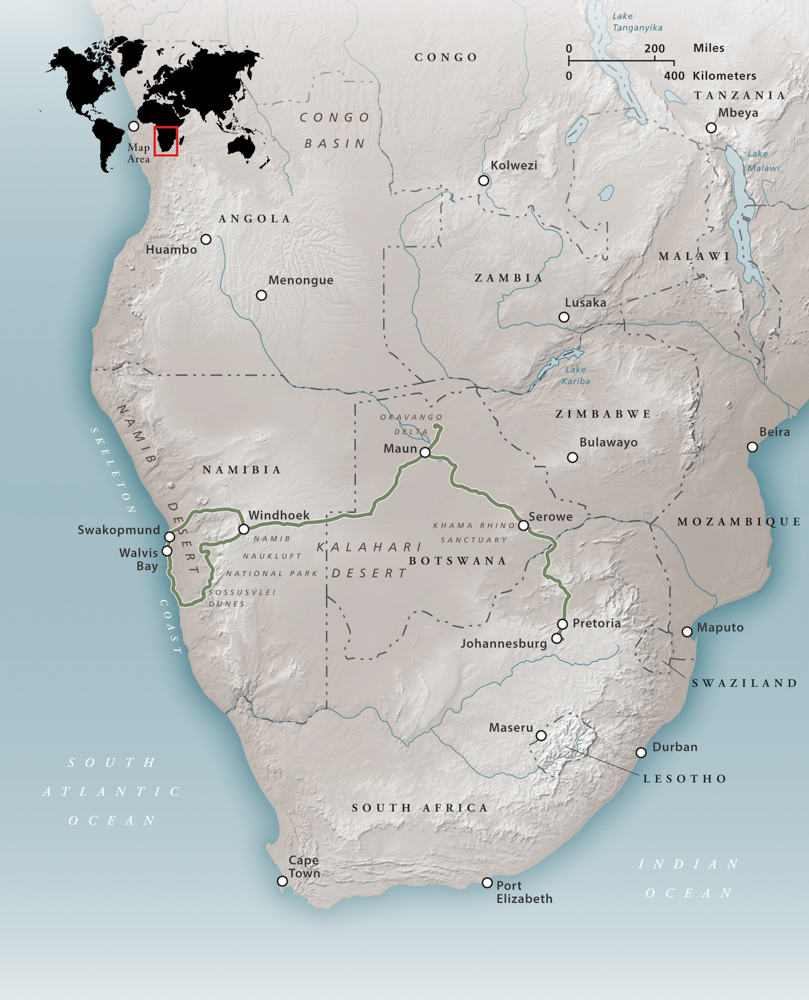


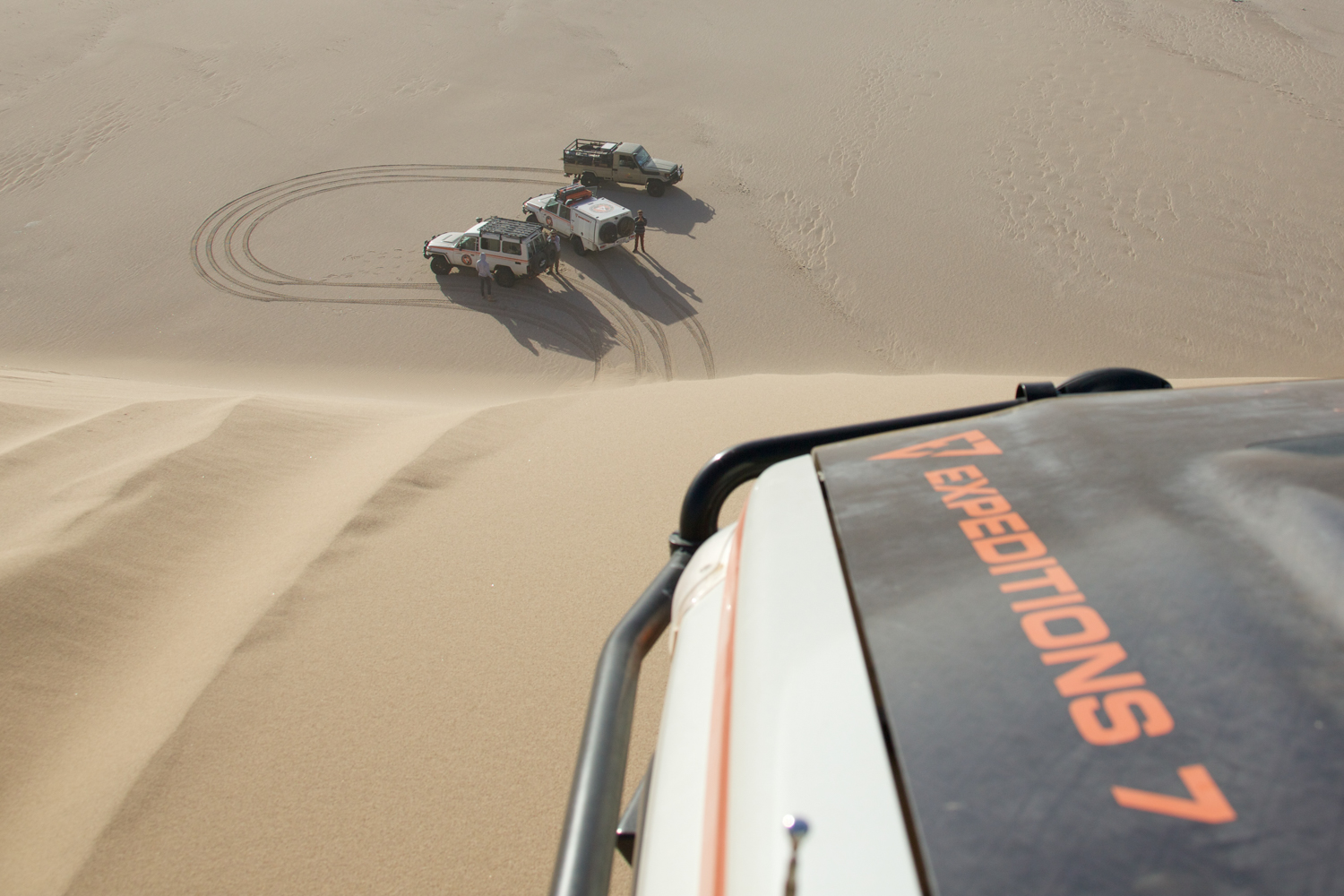

One Comment
JULIO GARCIA
January 18th, 2019 at 11:58 amExcelent article.